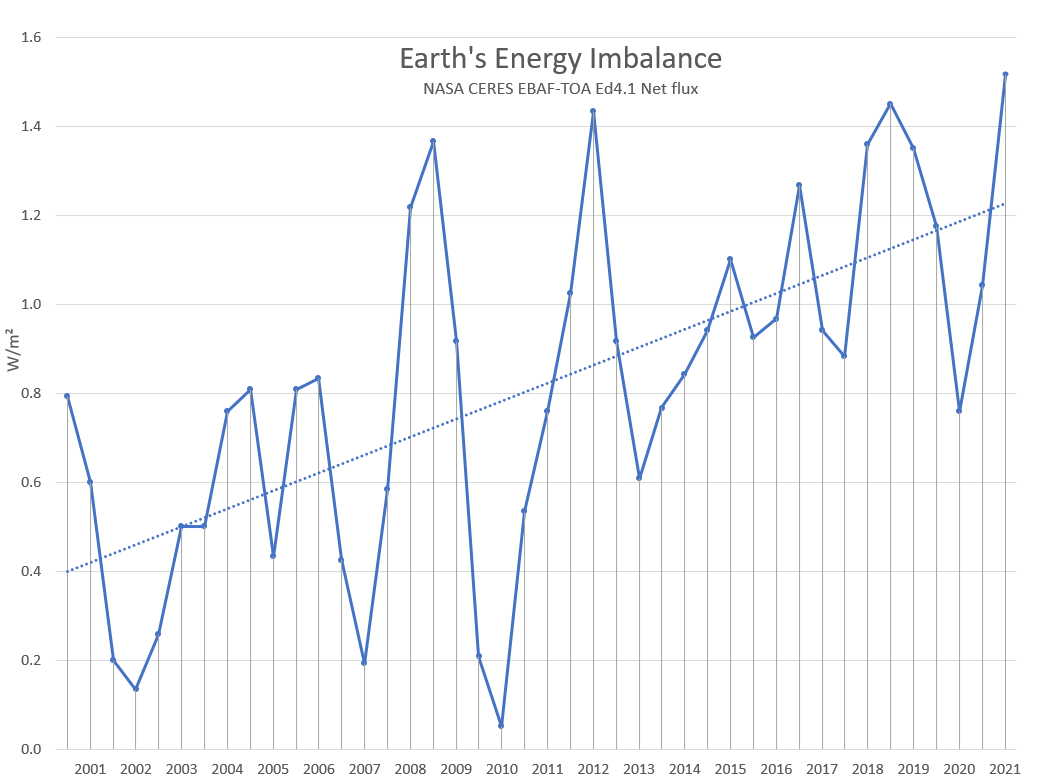-
Posts
4,335 -
Joined
-
Last visited
Content Type
Profiles
Blogs
Forums
American Weather
Media Demo
Store
Gallery
Posts posted by csnavywx
-
-
On 12/12/2022 at 12:18 PM, LibertyBell said:
Some news
This is big news today-- how many decades are we now from controllable nuclear fusion and could this eventually be used not just for energy right here at home but also for space propulsion fuel?
Q-plasma only. Nowhere near break-even on Q-total. Entire fusion research community needs to come to grips with this and tell it like it is or we're gonna get another 30 years of articles like this.
-
 2
2
-
-
51 minutes ago, Brian5671 said:
10000% this. Wind will be bad enough but this kind of rainfall is devastating. Overnight/diurnal enhancement of training feeder bands and downshear enhancement north/northwest of a slow moving eyewall could produce some hellacious rainfall amounts.
-
 7
7
-
-
2 minutes ago, A-L-E-K said:
fort
meijersharveyfyp
-
Ian going for the Harvey Jr. award, I see.
-
 3
3
-
-
-
2 minutes ago, hawkeye_wx said:
Looks either elongated or like there may be another center south of the initial wind shift area. Mid-level center is more apparent on satellite as being SW. Still displaced. Convection is a lot better but until we get some clarity on which area becomes dominant, track is going to be up in the air. The far left and right side of the envelope most likely result in a strong hurricane landfall. Fast and up the center result in a shredded system under 40-60kt of vertical shear. Cross sections clearly showing those solutions to result in a classic, textbook case of rapid eyewall collapse. It speeds up and makes landfall to the right before shear can tear it apart or slows down to the left before it reaches the hostile area and decelerates as the trough pulls away.
-
 3
3
-
 3
3
-
-
Shear peaked this afternoon and should be starting to relax (though still around 30kt). Should be around 20-25 by morning. Shear and movement vectors starting to align better. Not surprising we're seeing starting to see some development. Faster development here would result in a left-of-track bias due to vortex tilt "dragging" the low level circulation with it.
-
 7
7
-
-
This is going pretty much how I expected. Careful with that ASCAT data though, the mid-level circulation is likely displaced south of the actual max low level curvature.
When the steering vector gets more aligned with the shear vector in about 48-60 hr, it might be able to sneak some development in as shear drops below 20kt. Has to get through some rather brutal 35kt shear tomorrow though.
-
 3
3
-
-
3 hours ago, Superstorm93 said:
That's honestly what I'm betting on at this point. I think continued development over the next 72 hours remains slow.
Yep, max layer shear stays 25-30kt for a good 48-72 hr before relaxing. Development will be slow and convection likely to be mostly relegated to the southwestern part of the circulation. Could easily see a south-of-forecast-track bias due to that shear.
-
 2
2
-
-
On 9/1/2022 at 9:52 AM, ORH_wxman said:
Update:
NSIDC area remains at 3.50 million sq km....same as 2 days ago (technically 5k higher as 2 days ago it was 3.496 and today is 3.501).
I highly doubt the minimum has been reached as 8/29 would be the earliest minimum on record (1992 had a min on 8/31). But we'll see if it can drop low enough to get below 2018's 3.23 million sq km minimum. I would bet against that at the moment, but there is a chance we could see one last burst of increased melting with the East Siberian Sea arm of ice still vulnerable.
Here's where other post-2007 years stand now:
2021: -320k
2020: -740k
2019: -530k
2018: -130k
2017: -430k
2016: -840k
2015: -170k
2014: +260k
2013: +290k
2012: -1.05 million (-1050k)
2011: -480k
2010: -230k
2009: +170k
2008: -250k
2007: -390k
A solid year, right up there, if not quite as good as '09 and '13. Looking at EOSDIS and AMSR, this year is definitely being held up by that now-typical ESAS arm and a remnant Beaufort arm. I was kinda hoping we'd see more of the Beaufort survive since that's where the real MYI nursery was in the past. But alas, looks like most of that got melted anyways. I think that July dipole kinda took it from a '13 kind of year and knocked it down a peg in that sector. Seems to be the key difference between the pre-and-post-2007 era. Well that and the surface warming and shoaling of Atlantic water in the Barents area.
-
This weekend looks glorious. Dews dropping into the 50s with low 80s highs is my kind of jam.
-
 4
4
-
-
On 6/22/2022 at 6:37 AM, donsutherland1 said:
Yesterday’s low temperature of 86 at Galveston was that city’s earliest such minimum temperature on record. The previous mark was set on August 8, 2019.
Yuck. Poor overnight recovery is what makes big heatwaves truly miserable and deadly. No relief.
-
 2
2
-
-
On 5/30/2022 at 10:51 PM, DTWXRISK said:
The video from 2011 ---watch it 2x and note all the predictions that joe blowhole BUSTardi got wrong.
https://youtu.be/3mzUjn2Z-2EYou're being generous. He didn't even make it 5 years with this one. Him and the rest of the AGW minimizer crowd were alllllll over the place proclaiming GW was dead as the main driver when that Super Nina hit.
He's like the best contrarian indicator ever. If the guy was a stock, being short would be making a killing.
-
The mid-deck from earlier in the day almost crapped out the entire party. We'll have another chance here this week if we can get an MCS to ride the EML instability gradient or this weekend, provided the BL doesn't get mixed out with all the heat.
-
 1
1
-
-
22 hours ago, LibertyBell said:
aren't cornbelt farming practices now leading to higher humidity and more severe weather though?
dry heat is a lot better than humidity.
We're building ourselves a bit of a trap with agricultural climate effects. Summertime temps are kept down by the increase in humidity, offsetting warming. However, this cannot continue indefinitely. Plateauing crop density and water evaporation will lead to eventual temp rises that will begin to put pressure on the crop, eventually causing this effect to fail and warming to snap back pretty quickly in a few decades.
-
 1
1
-
-
17 minutes ago, Eskimo Joe said:
Not really sure where else to post this question, but has anyone else noticed that we've been getting these late season -NAOs more often? Seems almost like clockwork we get a blocking pattern late March into mid April then we're right into summer.
Yep, it's been a thing for several years. You're not the only one:
TLDR: A bit of reasoned speculation, but probably due to downstream effects of rapid warming in the North Pacific. Looks like a transient decadal response to me.
-
 2
2
-
-
2 minutes ago, Buckeyes_Suck said:
I just started reading it after listening to the latest Jordan Peterson podcast.
I can't comment on that piece specifically, but am familiar with his positions broadly.
If I'm going to address something, it'll mostly be on the science side.
-
 1
1
-
-
30 minutes ago, Buckeyes_Suck said:
Anyone else here read this?
False Alarm by Bjorn Lomborg
Let's hear what your doubts are and what you would have to see to change your mind. If you want engagement here, you need a falsifiable position to begin with.
-
On 4/6/2022 at 2:30 PM, bluewave said:
It could be a great technology if done cost effectively enough for widespread use.
https://www.prnewswire.com/news-releases/first-light-achieves-world-first-fusion-result-proving-unique-new-target-technology-301517509.html- Fusion shown with projectile approach for first time, validated by UKAEA
- Breakthrough achieved faster and cheaper than traditional fusion approaches
- Unique target approach offers simpler pathway to low-cost fusion energy using existing plant technology
- Projectile approach enables a high-margin consumables business model with an addressable market in the hundreds of billions
-
On 4/3/2022 at 10:48 AM, skierinvermont said:
it doesn't, for two reasons. We've talked about this before. It's just not going to happen. One it costs twice as much as solar, wind, and natural gas. But second, and even more importantly, natural gas plants are very cheap to build but expensive to operate, which makes them ideal backup generators. They allow you to get the grid to 70 or 80% wind/solar without even needing storage capacity, which would be a monumental accomplishment. Nuclear plants are extremely expensive to build and cannot be used as backup generators. The next step to get to 100% renewables, probably involves storage and smart grids. Not nuclear.
We're not going to make 2C without it -- though I have my doubts we can even hit that target if EEI merely stays where it's at and aerosols are reduced. Decarbonization isn't fast enough and hasn't been for a while. Energy efficiency doesn't work very well due to demand equilibrium changes. If we need to subsidize and standardize the reactor design, then so be it. It's still way cheaper than CCS/BECCS and seasonal storage -- both of which are necessary en masse to hit 2 or 1.5C. The damage function is non-linear and gets pretty scary after we hit those limits. So will the costs, and those costs are likely to make this little cost-benefit analysis look quaint in comparison.
A good article and published paper linked in that thread as well.
Long story short -- rate of decarbonization is all that matters and that rate must exceed growth. We will either do this voluntarily or it will happen via painful forced deleveraging and a decline in growth rates as the cost of damage piles up and more energy is thus used for maintenance of the existing capital stock. That's to say absolutely nothing of the geopolitical ramifications of all of this. And that geopol risk is probably not going to be constructive for decarbonization efforts, if recent history is any guide.
-
 2
2
-
 1
1
-
-
Yikes at the new CERES data. +1.5W/m2 imbalance last year. +1.2 W/m2 trend gives about +0.9C of equilibrium warming, if my back of the envelope calculation is correct. We've already probably blown +2C and at this rate of emissions, I wouldn't be shocked to see a sizeable uptick in the rate of warming this decade.
-
 4
4
-
-
Presence of a deepening MAUL (moist absolutely unstable layer) on these forecast soundings makes me think the wind gust potential will overperform here. Cold advection powerful enough to produce that usually has no issues in transporting momentum to the surface. Also, the frontal slope gradient is so sharp, it's very possible that ptype flips earlier and stays sleet longer than forecast.
-
 6
6
-
 2
2
-
-
9 hours ago, chubbs said:
There is a double whammy as aerosol emissions decrease in China and other developing countries, which also increases forcing. The good news: methane emission reductions would have a rapid impact due short lifetime. We should be using methane reductions to offset the forcing boost from reduced aerosols.
It would -- though it's not clear that we're going to get any help from nature now if microbial sources are indeed increasing, especially if it's a result of warming temperatures over tropical wetlands. That could be a tipping point mechanism.
-
 1
1
-
-
On 2/10/2022 at 11:04 PM, Vice-Regent said:
If the problem regarding absent negative feedbacks is really that severe not only do the ocean's have more room to heat (forcing in the pipeline) but also do it more rapidly.
Ocean heat uptake is poorly misunderstood especially by the public. 98% of the additional radiative forcing goes into the ocean and the remainder land regions and ice caps. This may be a rare instance where I suggest geoengineering as the problem appears to be very severe and an extinction event in it's own right (first in the seas and spreading onto land).
Yep, most of that additional heat will go into the oceanic flywheel for later. Just didn't expect that level of additional forcing so quickly. I expect we'll feel some of that on the next Nino, for instance.
-
 2
2
-








worst long term prediction ever ?
in Climate Change
Posted
Doesn't matter what ya throw at him. It won't work. The only thing that matters is this when engaging in this sort of discussion:
What would it take to invalidate your position?
If he can't state it clearly at this point -- block and move on.
Tired of the years of coddling this shit on this board. It's tiring.